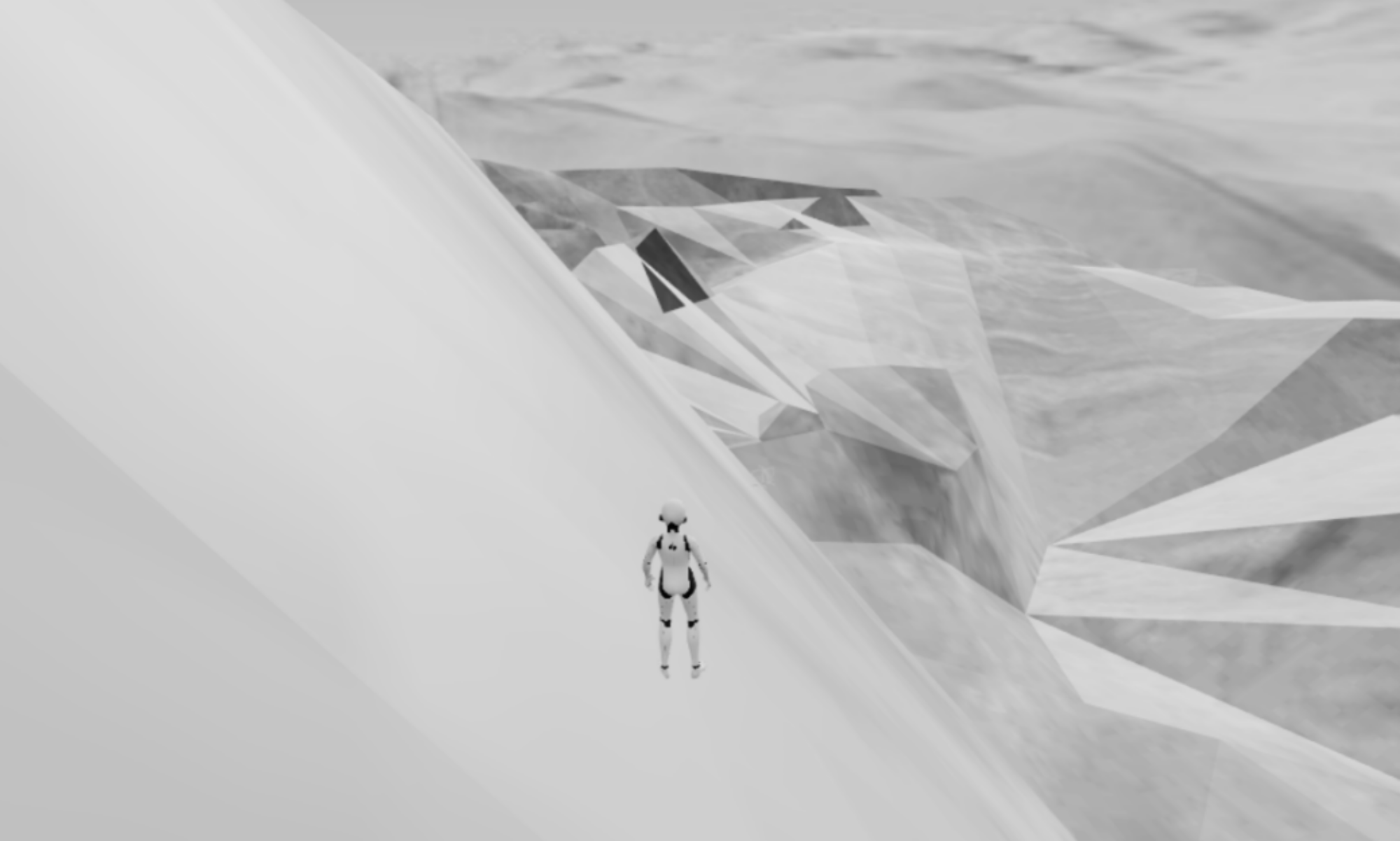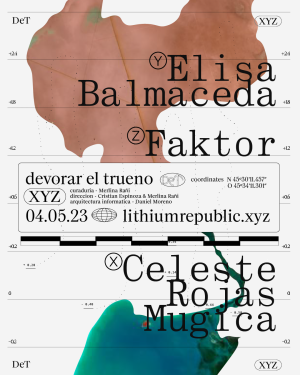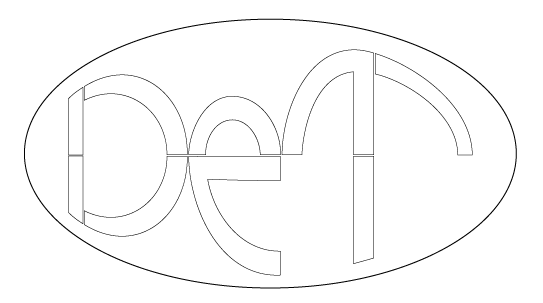
DEVORAR EL TRUENO - DeT
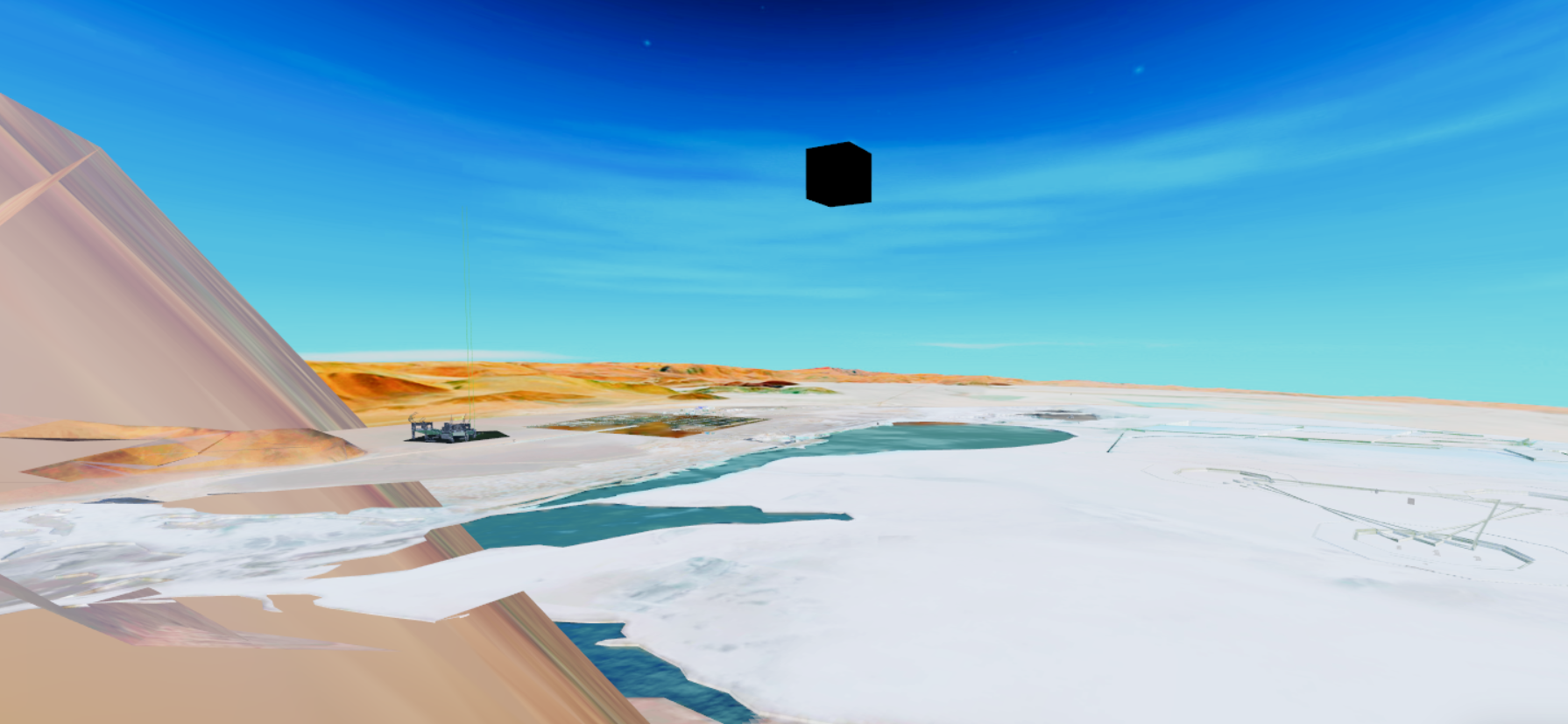
Participating Artists: Elisa Balmaceda, Celeste Rojas Mugica, and Faktor.
Curated by: Merlina Rañi.
Exhibition Design and Signage: Faktor.
Hosted within the virtual beta twin of Salar de Hombre Muerto
Territory Design: Cristian Espinoza
Development Consultation: Daniel Moreno
This exhibition served as an initial exploration of the platform’s capabilities, focusing on strategies to portray the vast dimensions of this location within a simulation environment—the metaverse. The result was a journey through three installations that delved into topics such as the fear inherent in shaping national identity, the uncanniness of decontextualized cultural codes, and the projection of potential future ruins.
“Devorar el Trueno” is a virtual exhibition featuring works by Faktor, Elisa Balmaceda, and Celeste Rojas Mugica, curated by Merlina Rañi. The exhibition is hosted within the virtual twin of Salar del Hombre Muerto as part of the overarching project, Lithium Republic XYZ.
This exhibition represents an initial exploration within the beta version of Lithium Republic XYZ, centered around the question of how to virtually depict the current and factual reality of a specific location. It also delves into the shifts such representation brings to artistic discourse and practice. Each artist introduced an element into the simulation space to capture aspects of the location’s complexity across temporal layers and its relevance within the political agenda—exploring themes related to energy transition, ecology, and globalization.
The goal was to encapsulate the expansive nature of a salt flat. Each case was approached through an abstract coordinate system: at ground level (X), extending vertically towards the sky (Y), and considering volume (Z). Together, the artworks highlighted themes like
contemporary uncertainties about future ruins, the necessity to perceive time from a human perspective, and the wealth of an ecosystem that defies the common misconception of being a desert. Through the three distinct perspectives, a unique sense of extensity emerged, translating the spatial feeling into a conceptual space, along with a deep connection to ancestral roots. Each artwork, in its own way, offered insights into the location’s temporal layers and historical context.
The curatorial process also confronted challenges, encompassing the representation of physicality, addressing technical limitations, exploring narrative possibilities, and enhancing the user experience. To guide the curatorial journey, an unfolding storyline was crafted, driven by an emergent narrative logic. This approach introduced a non-hierarchical order that unfolded through the experiential process. The narrative centered around the enigmatic figure of the “hombre muerto,” gradually uncovering themes prompted by the artworks and providing contextual information about the location.
X
Devouring the Thunder to Say Poetry
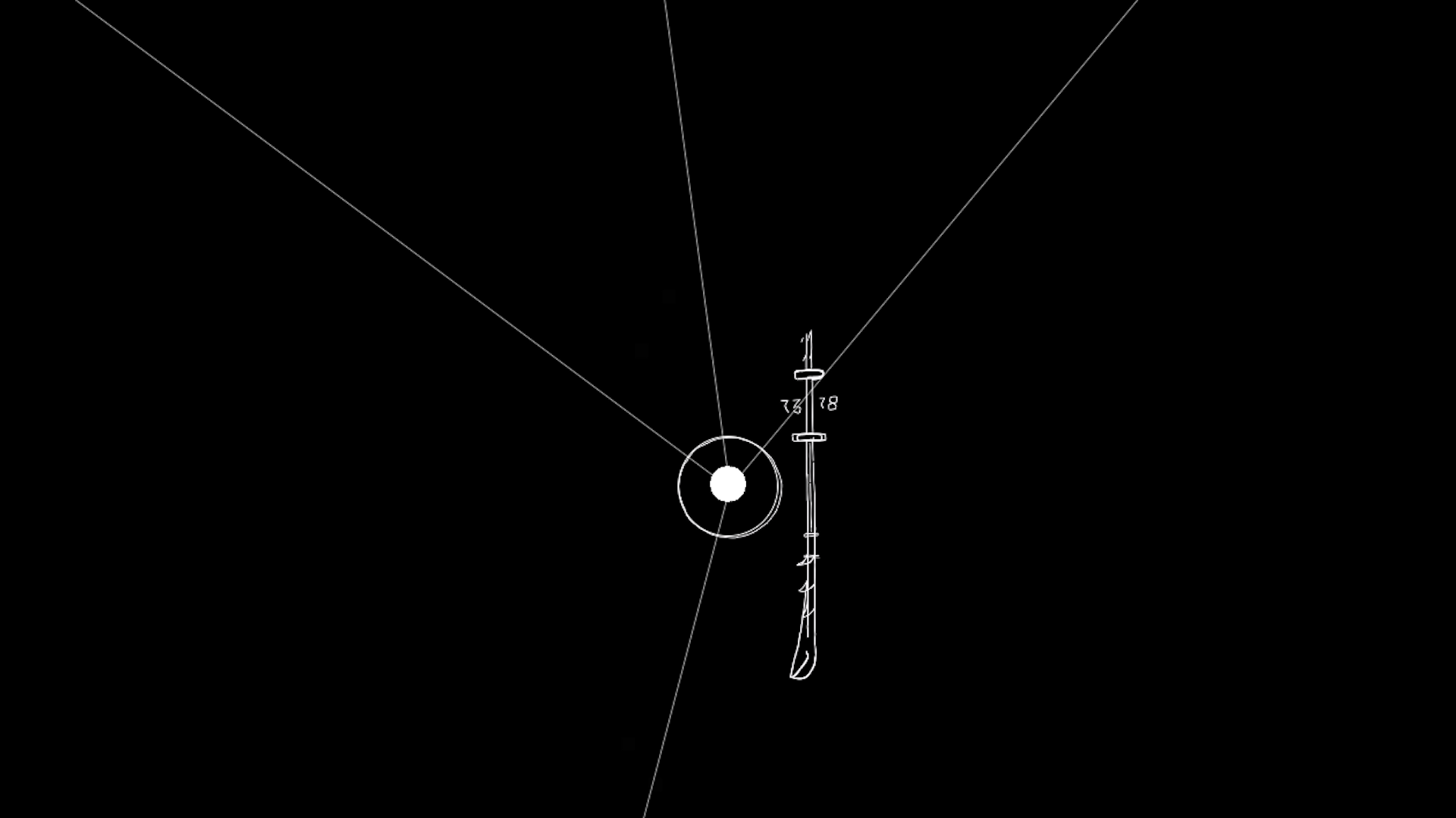
The Pulse of the Salt Flat’s Nervous System
Regarding “Ejercicios de Aridez” by Celeste Rojas Mugica
From 2017 to 2021, Celeste Rojas Mugica delved into an investigation of a geoglyph discovered in the Atacama Desert. The geoglyph in her focus is modern, depicting a 2-kilometer-long curved knife, authorship unknown, with the numbers 73 on the left and 78 on the right. The drawing, massive and somewhat indistinct, is scattered with signs pointing to milestones of Chile’s recent military dictatorship and a specific period between its inception and the “television withdrawal” operation. However, it also carries the symbolism of the knife as an emblem of national power over borders and neighboring nations. This weapon became a symbol of patriotism due to its use in the War of the Pacific, known for its capacity not just to wound but to entirely devastate its victims. This skill evokes that of a butcher, resulting in an implacable effect while simultaneously laying national foundations in terror.
After conducting on-site research alongside a geologist, Celeste embarked on a series of exercises exploring the symbolic power of this enigmatic monument. The results were profoundly insightful and conveyed a devastating poetic quality. Amid the varied accounts of the location, history, and drawing, a central question emerged about the intrinsic connection between the concept of a physical map and a political one. This inquiry was further explored in a publication written by her brother, the writer and poet Martín Cinzano.
This convergence of records and writings led to the exercise we see displayed as a triptych in a dimly lit room: a poem encrypted in Morse code, transmitted using a flashlight across the vast nocturnal expanse, bridging the points of the investigated territory.
Positioned in a different context, the artwork becomes a distant beacon within the explored territory—a nervous pulse that lays bare the intrinsic link between salt flats as an ecosystem, indifferent to political boundaries and instead responding to shared conditions. The poem in Morse code requires a certain level of readiness for interpretation. To those unable to decipher it, it holds a covert yet unmistakable message: war and secrecy. As the poem unveils its meaning through decoding, aridity strikes at the heart of language. The efficiency of this code, and the exercise itself, stand as an endeavor to convey something strikingly austere.
“Ejercicios de Aridez” weaves a cohesive body of work that adeptly bridges historical epochs and issues within a specific territory. From Atacama’s past as a former Bolivian domain to its role during the military dictatorship and the intricate interplay between violence and the construction of a national identity underscored through modern institutions and education.
In parallel, it emphasizes the age-old practice of geoglyphs as a means of signification within arid landscapes. This underscores the enduring permanence of their inscriptions and the intervention of their encoded language.
Celeste Rojas Mugica (Chile, 1987) She is a visual artist, photographer, and filmmaker. Currently, she is pursuing a Master’s degree in Film Creation at Elías Querejeta Zine Eskola – EQZE (Basque Country). In her work, she investigates the relationship between memory, violence, and imaginaries of the territory. She works with images and archives as means and materials for experimentation around their social uses and political potential, situating her practice at the intersections of fiction and documentary.
She has recently exhibited her work at BIENALSUR (Argentina; Chile), Ars Electronica (Austria), Les Rencontres d’Arles (France), the Biennial of Moving Images (Argentina), the International Film Festival of San Sebastián (Spain), and UNSEEN (Netherlands), among others. She lives and works between Buenos Aires, Santiago, and Donostia-San Sebastián. https://celesterojasmugica.com/
Y
Devouring the Thunder to Perceive the Ritual

A Gaze That Truly Sees
Exploring “Observatorio de un futuro-pasado (cíclico)”
“Observatorio de un futuro-pasado (cíclico)” brings to the forefront the innate connection between time and space observation, intricately intertwined with the concept of the present. Within an abandoned electrical booth, a structure either nearing the end of its functional life or no longer in use, an astronomical water mirror takes center stage. While the structure represents impermanence, the mirror embodies an efficient and ancient Andean technique used to navigate the celestial expanse.
Astronomy occupies a fundamental role within Andean culture, an ancestral pursuit that meticulously structured numerous aspects of life across various cultures. It extended from the arrangement of settlements and ceremonial hubs to the calendar, harvests, and diverse craftsmanship such as textiles, ceramics, and metalwork. The celestial rhythm bestowed profound significance. Through these mirrors, phenomena ranging from singular occurrences like eclipses and solar spots to constellations and planetary movements were scrutinized. Virtually all symbolic expression within the Andean culture stems from this profound study.
Elisa Balmaceda’s installation features certain elements that immediately evoke a narrative: the imminent shift of a civilization away from fossil fuels, the electrical booth as a symbol of an era defined by progress, and the diversification of an unfamiliar future likely rooted in the past. However, at the core of this transitioning space (and its mystery) stands an observatory that relies on minimal technology—a water mirror and a receptive, inquisitive perception.
Elisa introduces a mirror laden with symbolism to an explored territory, offering the means to study the cosmic nature or perceive beyond representation—stepping out of our world to gain understanding through a reversed mirror, providing a different perspective. The astronomical viewpoint offers the broadest scope through which we can observe something, yet it’s more than just a glance; it’s a perspective that truly comprehends. The perception of a distinctive space-time involves understanding it and the imperative to structure it for an ontological connection.
In this lies the essence of what’s perceived, ultimately unveiling itself as ritual—a methodology that empowers us to engage with time and knowledge.
Elisa Balmaceda (Chile, 1985)
Transdisciplinary artist and educator. Following an experimental investigation into invisible ecologies and energies, cosmic-planetary alignments and geometries, technologies of vision and optical instrumentation, decolonial notions of space-time, and Andean phenomenology, her practice focuses on relating, deconstructing, and reimagining the material and spiritual links that interweave the biosphere and technosphere beyond the human within a degraded body/planet. She pursued a master’s degree in art and technology at the Academy of Media Arts Cologne (Germany, 2016) and a bachelor’s
degree in visual arts from the Universidad Católica (Chile, 2007), in addition to informal studies in expanded cinema, archeoastronomy, botany, and Andean semiotics. Her work has been exhibited in galleries and museums in Chile, Germany, the United States, Spain, Belgium, Argentina, Colombia, Mexico, Serbia, among others. Currently, she works as an educator at the LAB de Arte & Ecología at the University of Concepción (Chile) and is also a co-creator of the visionaryecologies.xyz platform, an art and science project in collaboration with the Rachel Carson Center for Environment and Society (Germany).
Z
Devouring the Thunder to Unravel Fiction
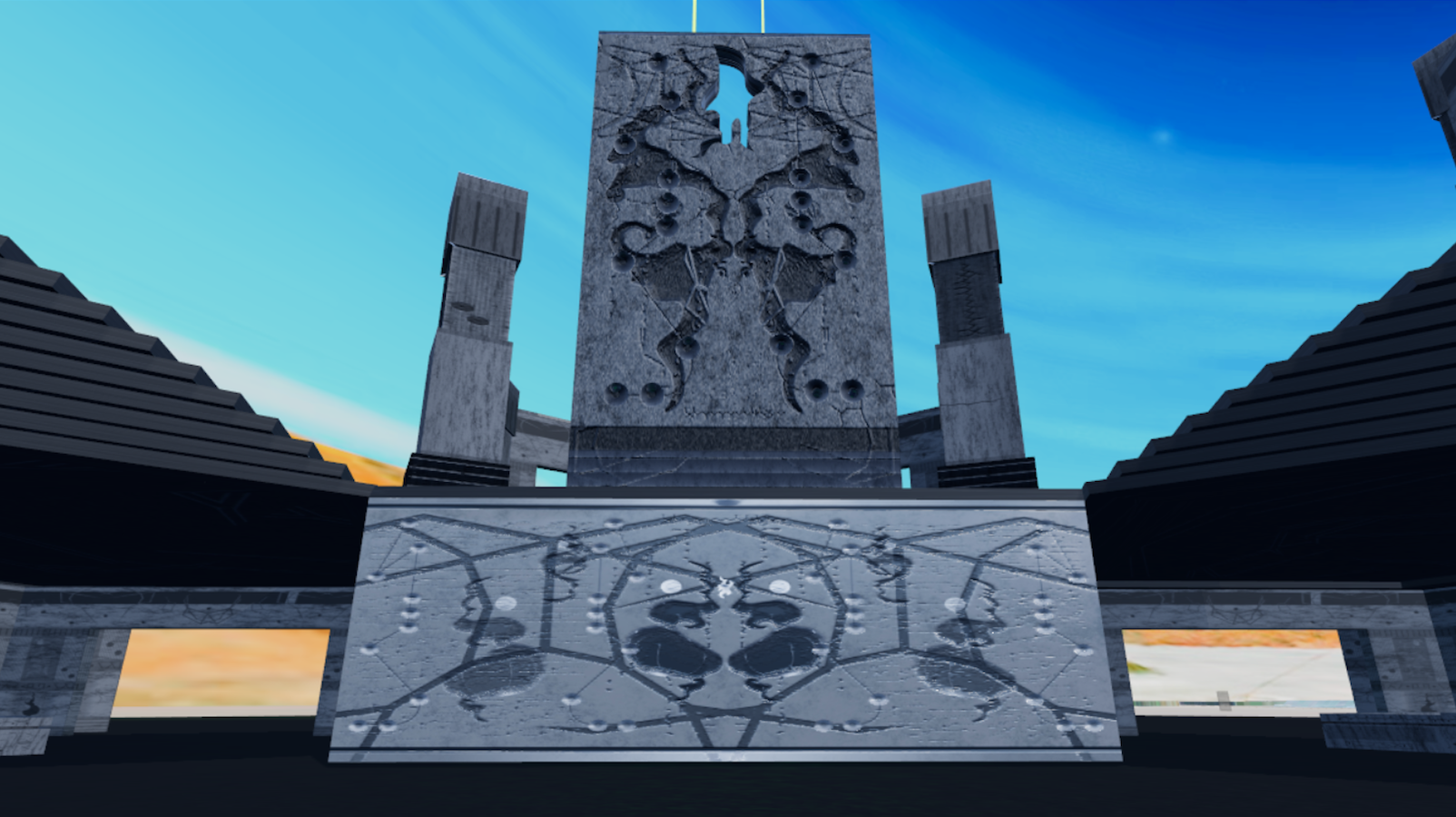
An Illusion for Immersion
Regarding “Negro será el sol en verano” by Faktor
The path to representation leads us into the depths. The volume of forms, whether real or simulated, sheds its fictional constraints as we engage as active participants in this experiment. Belonging to reality in multiple ways has been an unconscious act until now, finding new significance in proposals for virtual representation. And so, a portal opens, revealing something that exists neither in the past nor the future. However, the gap between our experienced reality and the mechanisms required to simulate it feels intriguingly unfamiliar.
In this context, a series of forms are introduced into this expansive realm. Whether they collectively emulate a temple, suggest mechanisms, or exude ceremonial essence, it remains an enigma; the only way to uncover its essence is through the lens of fiction, just one of many conceivable perspectives. This imaginative exercise is common in scientific disciplines like archaeology, paleontology, and biology, where speculation often becomes a necessity to grasp subjects devoid of temporal, cultural, or contextual clues. The ultimate question is, what kind of biases might guide such speculation?
So, interpreting what we see becomes a journey into the farthest reaches of our imagination. As exemplified by Ursula K. Le Guin’s “The Carrier Bag Theory of Fiction,” a story can be about heroes or simply about life in its most fundamental poetic-pragmatic essence.
The elements projected before us resemble fossils from a moment that may not even encompass humanity. They emerge from a temporality that allows only for the present or emptiness, representing forgotten technologies and knowledge that paradoxically challenge the linear progression of time. It’s a system that thrives on the mystery it generates, thus transforming into a mechanism of adoration, a sharp departure from the familiar scale.
Amidst these radiant monoliths, a variety of objects appear. Whether we perceive them as technology or not prompts us to redefine the concept personally and construct a narrative that links our existence to these objects. Consider a vessel that reshapes the organization of life—be it for storing food, recording stories, or containing water—all while providing a lens to observe or study the stars.
Amid these ponderings and inquiries, the Z coordinate calls into question the body’s role as a volume, a container for vulnerable life subject to mortality, and a participant in history—be it enduring or adaptable, present or extinct.
Facundo Suasnabar a.k.a. Faktor (Argentina, 1988) is a new media artist, composer, and technological developer. Through various mediums such as sculpture, installation, photography, and drawing, he explores the relationships and tensions between the organic, the inorganic, speculative anthropology, and science fiction.
Among his solo exhibitions, “Negro sera el sol en el verano” at ARtlab in 2023 and “Todo mientras sucede parece eterno” at CNBA in 2020 stand out.
Among the collective exhibitions and events he has participated in are: Salón Nacional de Artes Visuales at CCK (2022), Riesgo país at Newton Gallery NYC (2022), Vivero at Acefala Galería (2022), No existe tierra más allá at CHELA (2021), 16th National Contest UADE (2021), Ruido Cycle at CCK (2021). He is a founding member of the sound art collective AUTOBUZZ and a curator at the net label Strlac Records.
Curatorial Text - Situated
“Devorar el Trueno” is an orchestrated essay centered around the Salar del Hombre Muerto. Navigating within this simulation is like bridging distances, grasping the portrayal of depth, traversing extension through time, and embracing intensity through rhythm.
Three elements have been introduced into this space, each located along the axes outlined in the central diagram (XYZ): an astronomical water mirror, an observatory of cosmic nature; an encoded poem containing information from another place; a portal to an inverted temporality, encrypting its access codes within fiction. In this realm, time doesn’t exist, only salt and the sun feels closer; the dimensions of mystery are immeasurable, but approximation is imperative.
Distance exists between this place and the cosmos, between other salt flats, the distant past, and the imminent future. There’s a distance within the present, a latency that dictates the rhythm. The gap between one pulse and the next, between forms, with the sun and other celestial bodies. All that can be achieved before reaching the end appears infinite, yet it’s merely a distance. To fathom its vastness or duration, one must journey from the core of oneself to the end of representation.
Diagram
About "Devorar el Trueno"

A diagram has been presented to visually convey the concept of the “Devouring the Thunder XYZ” exhibition. This diagram depicts the triangle figure in motion, symbolizing its nature as dynamic, transitional, and representative of the virtual environment it embodies.
This particular aspect is pertinent to the exercise of applying or adapting a practice within this experimental setting. Within this context, each participant engages in a form of representation, symbolizing what cannot be fully captured or embraced, but rather evoked. In doing so, a concept known as “extensity” is created – a concept found within medicine that is linked to the sensation of space and the body. It signifies a spatial quality that is relative to subjective experience, or even more profoundly, it relates to how the nervous system translates spatial dimensions into a conceptual idea. The crux of the matter is that in the space where artworks are positioned, physical space doesn’t truly exist; spatiality is gauged by the intensity of the experience. Moreover, time plays a pivotal role, as experience results in the passage of duration, intimately connected to the central element of the triangle: salt.
Here, time equates to salt; its duration aligns with the longevity of salt. Salt preserves, and when it’s absent, time loses its preservative element, dwindling away. From this axis, the triangle undergoes movement; it remains neither static nor faster than the eye can perceive, leaving behind a faint spectral trace. This trace signifies the movement of the observed object while concurrently encapsulating the multifaceted themes and layers proposed by the location. The curatorial process spills over with the diversity and richness of discourses related to the space, thus concentrating on intersections and how artworks harmonize with these intersections.
The triangle’s vertices denote coordinates – a representation of virtual spatiality XYZ. Within each of these coordinates, artists’ endeavors are situated, ushered in by their respective artworks. This placement adheres to their directional representation and the interplay among these angles. Inside each polygon, we encounter the element introducing the artwork, the action it encapsulates, and the manner in which it operates.
Moving along the X-axis, we encounter Celeste Rojas Mugica’s work, which is centered at ground level, focusing on the vast expanse of the territory and its attributes as land. The element initiating her work is code; the action involves expression, and the mode is characterized by poetry. Transitioning to the Y-axis, we find Elisa Balmaceda’s installation, directing her observation vertically towards the cosmos. She introduces a mirror as an element; the action involves perception, and the mode is characterized by ritual. Ultimately, within the Z-axis, Faktor’s work stands, which, in its exploration, generates volume, accentuating depth. In this context, the introduced element is form; the action pertains to deciphering, and the mode is rooted in fiction.
Between these vertices, we uncover a resonating connection stemming from the ancestral cultural layer of the location. This resonance is encapsulated by three words in Kunza, the language of the Lickanantai people: Kcoi (voice) between the body (Z) and the cosmos (Y), Lúlama (thunder) between the cosmos (Y) and the planet (X), and Caúr (mountain) between the planet (X) and the body (Z).
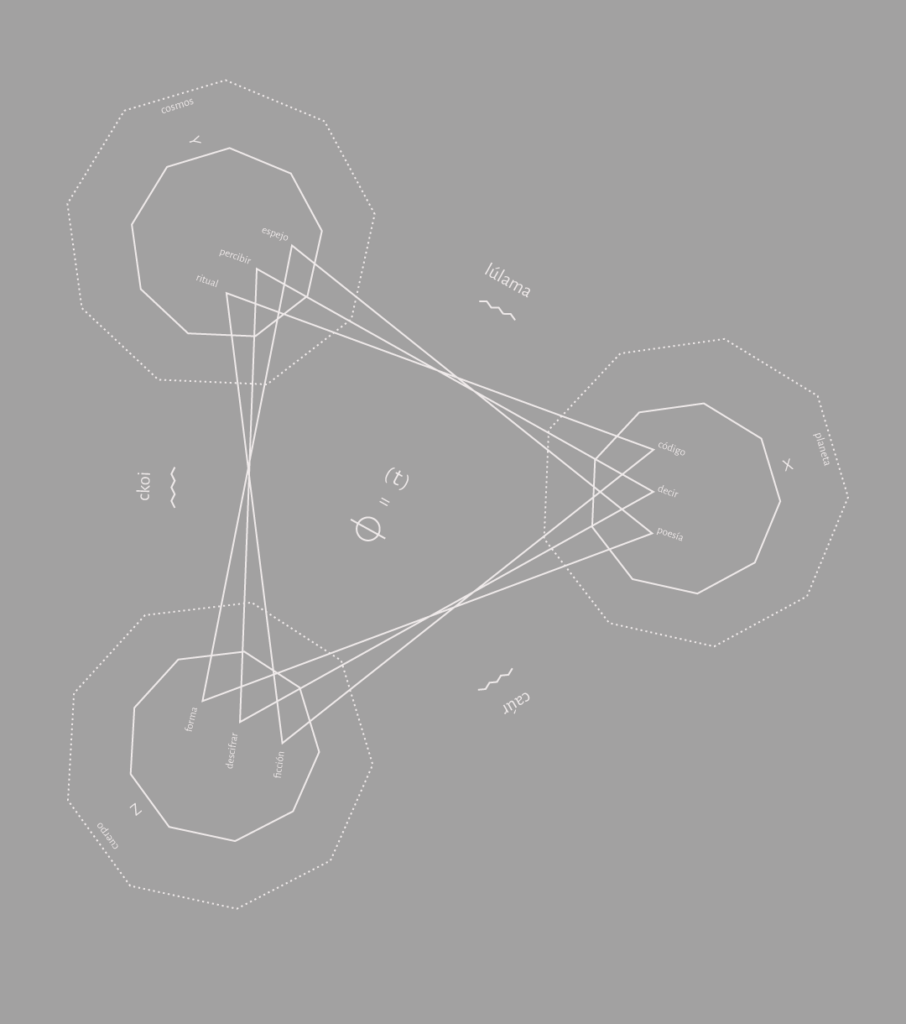
The Tale of the Dead Man
Written and narrated by Merlina Rañi (in Spanish)
Recording and post-production by Tomás Guida.
Available as part of the “Devorar el Trueno” (Devouring the Thunder) experience or on Soundcloud.
Within the exhibition’s context, a narrative was crafted and recorded to serve as the cohesive thread running through the showcase.
Near the fringes of the Salar del Hombre Muerto, situated in the highlands of Catamarca, two graves can be found. One of them belongs to an unknown individual who met their end in the vicinity and was laid to rest by the local community, christened with the moniker “Hombre Muerto” or “Dead Man.” This name was later adopted by Luciano R. Catalano, endowing the salt flat with a weighty foreboding. The narrative weaves a fictional tale around this mysterious figure, ensnared by a fate not uncommon for those unfamiliar with the perils of aridity. Drawing from accounts of journalists and researchers detailing the site’s characteristics, culture, and history, the fiction takes the audience on a brief journey.
For the “Devrar el Trueno” publication (Soon in English):
